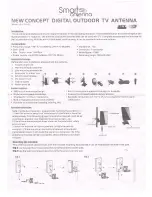
GENERAL DESCRIPTION
UNPACKING
Unpack the antenna and check the parts against the Parts List and the drawings. This will simplify
the antenna assembly. Parts have been separated when possible to aid in assembly. Make sure you
have the necessary room to assemble the antenna before unpacking. This antenna will be very large
when finished. Try to assemble it in a large open area clear of obstructions and people. A driveway and
a couple of saw horses or other means of support will make it easy to handle the antenna when putting
it together. Assembly over grass is not recommended. There are lots of small things that can get lost
forever in grass. Some parts may have extras included so don’t worry if you have some left over when
your done. The design of the antenna makes it very easy to assemble.
Tools you will need
WARNING
WHEN INSTALLING YOUR SYSTEM, TAKE EXTREME
CARE TO AVOID ANY ACCIDENTAL CONTACT WITH
POWERLINES OR OVERHEAD OBSTRUCTIONS.
FAILURE TO EXERCISE THIS CARE COULD RESULT
IN SERIOUS OR FATAL INJURY
2
The LFA (Loop Fed Array) Low-Noise Yagi is very different from the traditional dipole fed Yagi in many ways
with its primary benefit being unwanted noise rejection. The LFA has a rectangular shaped, full wave loop
driven element that is laid flat on the boom between and in-line with the parasitic elements . Then there is the
way in which the loop functions. The smaller end sections which run parallel to the boom, are engineered to be
180 degrees out-of-phase with each other. This provides the same effect as is seen within ladder-line feeder; each
side cancels the other out and therefore, minimum radiation occurs. In practice this translates to highly
suppressed side lobes and side-on signal rejection. This feature also plays a role in reducing F/B (Front to Back
ratio), F/R (Front to Rear ratio) and broad-banding of the antenna too. It is these attributes which help give the
LFA class-leading all-round performance at almost any boom length and for any given band.
Tape measure in inches.
A tape measure in feet and inches will do but you will have to convert.
7/16, wrench and/or nut driver
½ inch wrench
Phillips screwdriver
Flat head screwdriver
for hose clamps






























